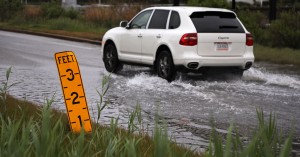From an Article of the Yale Climate Connections, December 1, 2020
Norfolk, Virginia, is home to the largest naval base in the world. The city is also on the front lines of sea-level rise. During high tides, water covers many roads.
“The arteries that go in and out of the naval base … those roads are now becoming flooded on a more regular basis. It’s becoming a chronic problem,” says Norfolk City Council member Andria McClellan.
She says the frequent flooding does not just impede traffic to the naval base. It disrupts residents’ lives. “The road that I travel to get to and from city hall is flooded several times a month now,” McClellan says. “I have to take a different route. It’ll be sunny outside, and truly the road’s impassable.”
On top of sea-level rise, storms are pouring more rain on the region. Many residents worry about flooding in their homes.
“When you add the two together, it’s really, truly the perfect storm,” McClellan says. “It is the biggest issue facing our city and our region.”
But McClellan says that adapting to more water will require massive and expensive infrastructure updates.
“And as a city we simply just don’t have the funding to tackle anything of that scale,” she says. “So we’re looking for the private sector…. We’re looking for government. We’re looking for NGOs. We’re looking under every rock to find funding to help us with the solutions.”
>>>>>. >>>>>. >>>>>. >>>>>. >>>>>.
See also: Seas are rising faster than ever | Paul Voosen, Science | AAAS, November 18, 2020
It is accelerating, big time. Faster melting of Greenland’s ice has pushed the rate to 4.8 millimeters per year, according to a 10-year average compiled for Science by Benjamin Hamlington, an ocean scientist at NASA’s Jet Propulsion Laboratory (JPL) and head of the agency’s sea level change team. “The [Greenland] mass loss has clearly kicked into higher gear,” agrees Felix Landerer, a JPL sea level scientist. With the help of new data, new models of vertical land motion, and—this month—a new radar satellite, oceanographers are sharpening their picture of how fast, and where, the seas are gobbling up the land.

